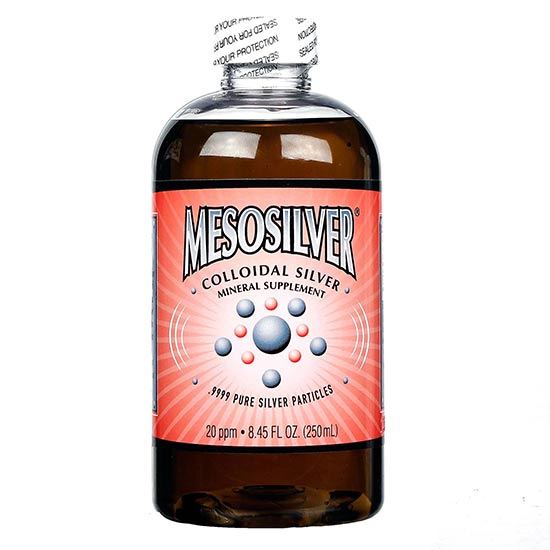As with any product, not all Colloidal Silver brands are created equal. Find a product that uses electro-colloidal production, rather than chemical processes, and check the label to make sure it only has silver and de-mineralized or distilled water. Careful investigation is warranted if a stabiliser or other trace components are listed as ingredients. It’s a red flag that there’s something else in the Colloidal Silver that could cause it to go bad if you’re told to keep it cold. No refrigeration is necessary, although Colloidal Silver should be kept out of the freezer. If Colloidal Silver is made in a concentrated form to be diluted, it may seem greenish grey with an orange tint in the light instead of the desired golden yellow. (Once diluted, concentrated Colloidal Silver should revert to its original golden colour.) Check the product out if you see a darker tint; it could mean that the silver particles are larger or that the water utilised contains minerals.
Amber or cobalt blue glass is ideal for storing colloidal silver, and the product should be kept in a cold, dark place once it has been opened.
Any product that requires you to “shake well before using” should raise red flags. Neither shaking nor stirring will affect the stability of colloidal silver.
There are a number of different ways to buy and store colloidal silver. There are several types of sprays, misters, nasal sprayers, droppers, salves, and compress solutions.
Extent of Silver Particles in Colloidal Solution: If you can get your hands on the data, another consideration while shopping for Colloidal Silver would be the product’s particle size and particle surface area. Products labelled as “colloidal silver” but which are actually compounds misrepresent the true concentration of silver. In addition, the silver’s surface must be in contact with the microbe or bacteria, and any proteins or salts connected to the silver particle will prevent the silver from interacting with its surroundings.
That being said, particle size is crucial, but not in the way you may think. The smaller the particle size of Colloidal Silver, the better it works.
The Silver concentration in Colloidal Silver is often reported by manufacturers in ppm (parts per million). This quantity is a reference to weight, specifically the mass of one part silver per million parts water. When particles are big, they don’t have as much surface area as when they’re broken up into smaller pieces. Consider the Rubik’s Cube. When intact, its surface area is quantifiable; when broken down, however, that number quickly grows exponentially as you add up the areas of each each smaller component.
Making Colloidal Silver at Home: There is merit in buying a generator to make Colloidal Silver at home. In this way, both the quality and the cost are under your direct management. Making your own colloidal silver at home only requires some time and distilled water. Your time may not be of the essence, since modern Colloidal Silver Generators effectively operate themselves once started on and will turn themselves off. Other generators may need regular monitoring, as changing the voltage polarity every couple of minutes is necessary when making huge quantities of concentrated Colloidal Silver to be diluted.
There are a few things to keep in mind if you plan on making Colloidal Silver at home. Good Colloidal Silver products can be made with a technique that requires simply silver rods and distilled water.
When making Colloidal Silver, it’s best to use distilled water of the highest quality. Not municipally supplied water, water drawn from a well, mineral water, distilled water, or de-ionized water. None of these liquids is conductive enough because of the chemicals and minerals they contain, and de-ionized water still has too many impurities. If you want to be in charge of your output, you need to pay close attention to the water. Sometimes you have to take a chance when picking out a brand of distilled water. The rule of thumb is to not go for the cheapest option. If you need to, you can also try several brands of distilled water. If the distilled water causes the Colloidal Silver to change colour, it still contains too many minerals and won’t work. If this occurs, you will need to restart production.
It’s important to note that if the generator maker recommends adding salt to the process in order to boost electrical conductivity and shorten the production period, you will end up with a silver compound rather than pure Colloidal Silver. When any kind of salt is introduced to silver, silver chloride will always develop. Additionally, the manufacturing time can be sped up with salt, but this comes with the risk of creating silver particles that are too big to remain suspended in the water for very long. And chemicals take longer to leave the body as a result.
As an aside, it’s recommended that you take a teaspoon of colloidal silver every day. There will be no discussion of this issue because it is ultimately up to each person. However, start with a minimal dose to avoid a rapid detoxification of the body. Toxins may be dumped into the bloodstream once the Silver begins working, and you may start to feel ill if you take too much. Even if you’re unwell when you begin taking Colloidal Silver, you shouldn’t take more than the recommended amount.
For the Final Word: We’ve had complete access to everything we require from the get-go. There’s certainly more to silver than just making pretty tableware and jewellery. Both positive and negative information on Colloidal Silver is easily accessible. Read between the lines: real Colloidal Silver, made with high-quality water and no additions, stabilisers, salts, or proteins, has never been linked to any adverse effects in humans. However, you shouldn’t stop your investigation with this paper.









































